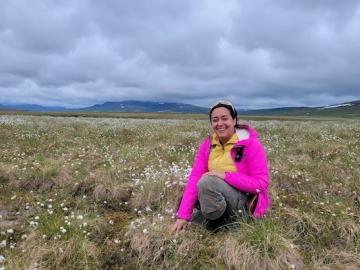Filter News
Area of Research
News Topics
- 3-D Printing/Advanced Manufacturing (2)
- Bioenergy (6)
- Biology (6)
- Biomedical (1)
- Buildings (2)
- Chemical Sciences (2)
- Clean Water (1)
- Climate Change (6)
- Composites (1)
- Computer Science (1)
- Cybersecurity (2)
- Decarbonization (7)
- Energy Storage (1)
- Environment (8)
- Grid (1)
- High-Performance Computing (1)
- Machine Learning (1)
- Materials (3)
- Materials Science (1)
- Mercury (1)
- Microscopy (4)
- National Security (5)
- Net Zero (2)
- Nuclear Energy (2)
- Physics (1)
- Polymers (1)
- Simulation (1)
- Sustainable Energy (5)
- Transportation (2)
Media Contacts

John “Jack” Cahill is out to illuminate previously unseen processes with new technology, advancing our understanding of how chemicals interact to influence complex systems whether it’s in the human body or in the world beneath our feet.

Having lived on three continents spanning the world’s four hemispheres, Philipe Ambrozio Dias understands the difficulties of moving to a new place.

Matthew Craig grew up eagerly exploring the forest patches and knee-high waterfalls just beyond his backyard in central Illinois’ corn belt. Today, that natural curiosity and the expertise he’s cultivated in biogeochemistry and ecology are focused on how carbon cycles in and out of soils, a process that can have tremendous impact on the Earth’s climate.

Materials scientist Denise Antunes da Silva researches ways to reduce concrete’s embodied carbon in the Sustainable Building Materials Laboratory at ORNL, a research space dedicated to studying environmentally friendly building materials. Credit: ORNL, U.S. Dept. of Energy

Tomás Rush began studying the mysteries of fungi in fifth grade and spent his college intern days tromping through forests, swamps and agricultural lands searching for signs of fungal plant pathogens causing disease on host plants.

Gang Seob “GS” Jung has known from the time he was in middle school that he was interested in science.

In human security research, Thomaz Carvalhaes says, there are typically two perspectives: technocentric and human centric. Rather than pick just one for his work, Carvalhaes uses data from both perspectives to understand how technology impacts the lives of people.

Though Scott Stewart recently received an Early Career Award from the Institute of Nuclear Material Management, he is regarded as a seasoned professional in the nuclear field with over 10 years of experience.

With wildfires increasing in scope and intensity around the world, Fernanda Santos’ research into how such calamities affect soil carbon storage has taken on new urgency.

When Bill Partridge started working with industry partner Cummins in 1997, he was a postdoctoral researcher specializing in applied optical diagnostics and new to Oak Ridge National Laboratory.




